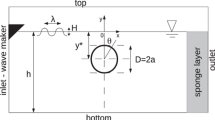Abstract
Flow disturbances produced by the slow relative motion of an impermeable body in a large, rapidly rotating vessel are studied as an asymptotic theory for an inviscid, incompressible fluid at a small Rossby number (ℛ≡u c /ΩL≪1). The axial distance between the vessel wallsH is assumed to be so much larger than the body scaleL that the reduced height Θ≡ℛH/L is of unit order or greater. This flow admits a columnar structure near the body and an outer nonlinear structure of the inertial-wave type far above the forcing region, at distances along the rotation-axis (z=0(L/ℛ)). The inner boundary condition for the outer problem is provided by transferring the impermeable surface condition through the columnar structure; the outer solution in turn determines the vorticity and the solution of the columnar inner region.
For thin obstacles or shallow ground topography (τ≪1), the outer solution is governed by an equation comparable to a linear one for inertial waves. The linear solutions obtained for steady transverse motion in an infinite domain (Θ→∞) shows that, in this case, surface (perturbation) velocities are orthogonal to those in an irrotational (non-rotating) flow over the same ground topography. In the far field, i.e., (\(\tilde z\)≡ℛz/L ≫l) disturbances are confined mainly behind a wedge-shaped caustic front downstream of the rotation axis\((x< - 2\sqrt 2 \left| y \right|)\), wherein their amplitudes are comparable to\(\tilde z\), in general accord with Lighthill's result from group-velocity consideration. The field behind the caustic supports, however, lee waves extending far downstream with diminishing strength. Their wave lengths belong to orderLℛz/x, and therefore these waves should appear to be densely packed in the wedge-shaped region. The question on tilting of the Taylor column is delineated; the structure of the caustic zone and its upstream flow behavior are also analyzed.
Zusammenfassung
Die Strömung um einen Körper, der sich langsam in einem grossen, rotierenden Behälter bewegt, wird untersucht mit einer asymptotischen Theorie für eine reibungsfreie, inkompressible Flüssigkeit bei einer kleinen Rossby-Zahl, d.h. ℛ≡u c /ΩL≪1. Der axiale AbstandH zwischen den Gefässwänden wird als soviel grösser als die Körperabmessung angenommen, dass für die reduzierte Höhe Θ=ℛH/L⩾ 0(1) gilt. Diese Strömung erlaubt eine säulenähnliche Struktur (Taylor column) in Körpernähe und eine äussere, nichtlineare Struktur vom Wellentyp für Höhenz=0(L/ℛ) über dem Köper. Die innere Randbedingung für das äussere Problem wird erhalten, indem die Bedingung an der Wand durch die Säule verschoben wird. Die äussere Lösung bestimmt ihrerseits die Rotation und damit die Lösung im inneren, säulenartigen Bereich.
Wenn Körper oder Bodenform flach sind (τ≪1), so wird die Aussenlösung durch eine Gleichung bestimmt, welche vergleichbar ist mit einer linearen Gleichung für Trägheitswellen. Lineare Lösungen werden für gleichförmige Bewegung von der Achse weg in einem unbegrenzten Bereich Θ→∞) gegeben. Sie zeigen, dass die Oberflächenstromlinien orthogonal zu den Stromlinien sind, die bei rotationsfreier (nichtdrehender) Strömung über der gleichen Bodenform entstehen. Im Fernfeld (\(\tilde z\)≡ℛz/L ≫l) sind Störungen hauptsächlich auf ein keilförmiges Gebiet stromabwärts von der Rotationsachse (\((x< - 2\sqrt 2 \left| y \right|)\)) begrenzt. In diesem Gebiet geht ihre Amplitude mit\(\tilde z\), in Uebereinstimmung mit Lighthill's Resultat, das mit der Gruppengeschwindigkeit hergeleitet wurde. Im keiförmigen Gebiet bestehen drei Familien von Lee-Wellen, welche sich mit unveränderter Stärke weit stromabwärts erstrecken. Ihre Wellenlängen gehören zur OrdnungLx/ℛz, weshalb die Wellen im keilförmigen Bereich dicht gepackt erscheinen. Die Frage der Neigung der Taylor Säule behandelt und die Struktur des Randes vom keilförmigen Bereich wird analysiert.
Similar content being viewed by others
References
J. Proudman, Proc. Roy. Soc.A92, 408 (1916).
G. I. Taylor, Proc. Roy. Soc.A102, 114 (1922).
G. I. Taylor, Proc. Roy. Soc.A104, 213 (1923).
M. J. Lighthill, J. Fluid Mech.27, 725 (1967).
R. Hide, A. Ibbetson andM. J. Lighthill, J. Fluid Mech.32, 268 (1968).
K. Stewartson, Quart. J. Mech. Appl. Math.6, 141 (1953).
R. Hide andA. Ibbetson, ICARRUS5, 279 (1966).
T. Maxworthy, Z. angew. Math. Phys.28, 853 (1977).
N. Rott andW. S. Lewellen, Prog. Aero. Sci.7, 111 (1966).
S. J. Jacob, J. Fluid Mech.20, 581 (1964).
H. P. Greenspan,The Theory of Rotating Fluids, Cambridge Univ Press, Cambridge (1969), p. 51.
G. B. Whitham,Linear and Nonlinear Waves, John Wiley, New York (1974), p. 419.
L. Meirovitch,Analytic Methods in Virbrations. Macmillan, London (1967), p. 375.
H. Ashely andM. Landahl,Aerodynamics of Wings and Bodies, Addision-Wesley, Reading, Mass. (1965), p. 129.
D. W. Moore andP. G. Saffman, J. Fluid Mech.39, 831 (1969).
H. Lamb,Hydrodynamics, 6th edn, Cambridge University Press, Cambridge (1932), p. 434.
L. G. Redekopp,Geophysical Fluid Dynamics,6, 289 (1975).
Author information
Authors and Affiliations
Additional information
This work is dedicated to Professor Nicholas Rott on the occasion of his sixtieth birthday.
Rights and permissions
About this article
Cite this article
Cheng, H.K. On inertial wave and flow structure at low Rossby number. Journal of Applied Mathematics and Physics (ZAMP) 28, 753–770 (1977). https://doi.org/10.1007/BF01603814
Received:
Issue Date:
DOI: https://doi.org/10.1007/BF01603814




